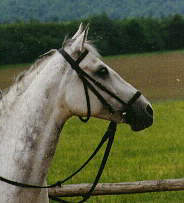
powered by FreeFind
| Main Page | Address |
| A-Z | Forum |
| German Main Page | |
|
Search
Web Search powered by FreeFind |
|
||||||||
 |
reiter.spass.com
Joy and Fun with Horses and Horseback Riding |
 |
Half and full halts.What are the half and the full halts actually? Authored by Beate Schulze and translated by Martina Wald |
||
|
||||||||
|
Half and full haltsYes who does not know the half and full halts? But honesty, who knows exactly what they mean? Full halts Full halts always ends with the stop of the horse, independent of the pace.
Half halts are necessary:
Therefore, you always need the half halt before you want your horse to do something. Carrying out: Many people believe a halt consists of a more or less strong pulling of the inner or outer rein. Often it is shown like that, but this is absolutely wrong! As any other aid, the halt must always consist of playing together of the following:
Where as the rein aid should have the lowest impact. Basically a halt consists of:
Due to the driving spine and leg aids the horse is made to step more intensively with its hindlegs. The hindlegs swing clearly under the body of the horse and the inner hindleg to the middle of the body. If there now comes the guarding and restraining rein aid, the horse slows ITSELF down. Therefore you can come, for example, into the next lower gait or to the halt. In any case a pulling backward of the hand must be avoided because the horse would hollow its back and sets up the hindlegs outside. You can test it again. Press the head backwards with your hands to the right and the left corners of the mouth. You will notice at once that your body attempts to go into a hollow back. That is not very pleasant, neither for yourself nor for your horse. Please try to stop running with a hollow back. The aids of half and full halts do not distinguish from each other, only the result does. And according to the strength of
driving, guarding, restraining and allowing aids you ride different exercises, you
make your horse more attentive, changing the gaits, etc. |
| Copyright © 2003 / 2007 reiter.spass.com, Forchheim, Germany | Disclaimer of reiter.spass.com | |
|
|
||